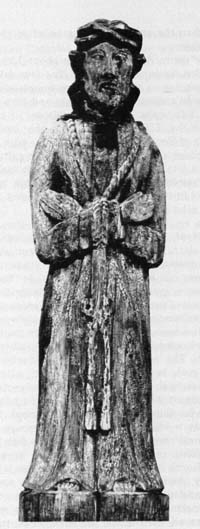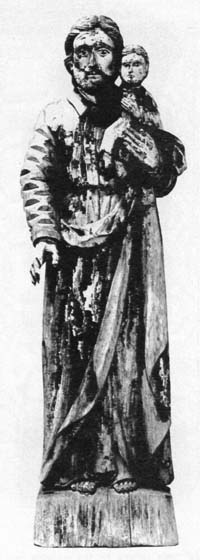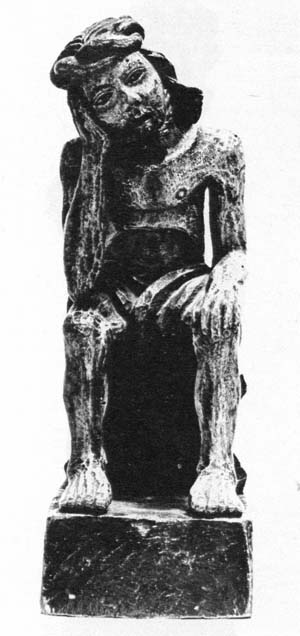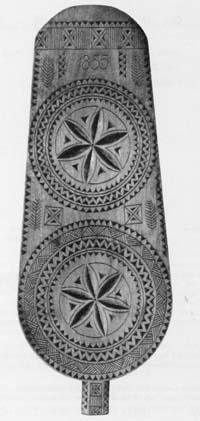Editor of this issue: Antanas Klimas
Copyright © 1967 LITUANUS Foundation, Inc.

|
LITUANUS
LITHUANIAN
QUARTERLY JOURNAL OF ARTS AND SCIENCES
Volume 14 13, No.2 -
Summer 1967
Editor of this issue: Antanas Klimas ISSN 0024-5089
Copyright © 1967 LITUANUS Foundation, Inc. |

|
ONE AMERICAN AND LITHUANIAN FOLK ART
VICTORIA FELDOM
On the evening of November 20, 1966 an exhibition of Lithuanian folk art opened in the Ethnic Arts Gallery, Los Angeles campus of the University of California. The preparation and research for the exhibition, as well as the catalog and the exhibition installation constituted the major portion of the writer's Master's Thesis granted by the Department of Folklore and Mythology at UCLA in June, 1967-
As an American of Roumanian-Jewish parentage, the work for the exhibition was a first insight into Lithuanians, Lithuania, and their culture as a distinct entity. For most Americans, Lithuania is one of the little European countries, not too well-known, beyond the usual tourist haunts. This encounter was a refreshing experience. It opened whole new horizons in an historical, theoretical, and aesthetic sense.
Aesthetically, Lithuanian folk art has a quality all its own. This can be emphatically stated on the basis of comparative study with other European folk arts. In matter and material, form and content there is a fusion of the tangible and intangible, the secular and the spiritual. The dievukai especailly, with an earthiness that is clearest in its formal elements, nevertheless personify those powers or concepts most concerned with the essence of life itself, its continuity and survival and fruitfulness on earth. The works most characteristic of Lithuanian folk art are the great crosses and chapels with their little inhabitants, the dievukai. Although other European Catholic countries have wayside crosses or other outdoor religious monuments, as the Austrian bildstoecke, none are like the Lithuanian crosses. These, for sheer inventiveness of form in the use of symbolic motifs and in their proliferation of architectural elements are unique to Lithuania. Other folk arts have carvings for the household shrines, but nowhere else do we have the rich development in a union of monument, image, and custom that constitutes a specific culture-complex. The dievukai, the spiritual center of the crosses and chapels, are consciously made to fit into their shrine niches. There is distortion in proportion that requires the carvings to be seen from below, a device utilized by the most sophisticated of contemporary sculptors. A non-representational style emphasized the other-word-ly orientation of the dievdirbis, although the peasant characterizations are derived from realist sources. The "god-carvers," masters of wood techniques, reject the shallow surfaces of versimilitude, and retain the ancient pattern of means used to make traditional artifacts. This can be clearly seen in an oval-gouge trait of distaff carvings that is also utilized on dievukai sleeves. The vertical quality, the conical structure, subdued coloring, simple abstraction of form, all of which are to be seen in the dievukai, impart a quality of dignity, of a quiescence that sharply contrasts with the more colorful, flamboyant carvings of other folk cultures. Lithuanian wea-vings, the beige-on beige textiles, in quality reveal the same economy of means, understatement in effects, and the proliferation of structural components. We find conservatism with little radical innovation in Lithuanian folk art- Rather, energy was expended to perfect the few elementary techniques, as in the weaving and carving, which were then multiplied for richer effects. This method required an intensity of purpose that resulted in objects with an intellectual rather than sensual appeal. In essence, Lithuanian folk art derives its major quality from an inner immovable integrity that is firmly committed to perfection of technique, appeal to the mind rather than the emotions, and a belief in the basic dignity of man.
How many Americans know about Lithuanian folk art, or Donelaitis, or Čiurlionis? The few dainos in English translation or their music are completely unfamiliar to the wide audiences which know and love many other national folk songs. The stirring history of the 300 year resistance by Lithuanians against the brutalities and invasions of Teutonic Knights should be part of our common heritage. Contemporary Lithuanian culture for most of us is a totally closed book although it includes works of great sophistication in all the creative media. How, ever, it is in its folk art that what is meant by „Lithuanian" is most apparent.
Folk art, or folklore in general is the „human dimension" of all culture history. Although rooted in communal traditions, folklore is an accumulation of all kinds of material by a people, rather than the singular expressions of separate individuals. In the universal search for origins or roots, one inevitably turns to folk expressions. Current creative works seem to have developed a homogeneous International style in every art form. Attendance at any of the current major art exhibitions or concerts of contemporary music ascertains this fact. The eternal struggle for identity, meaning, and life-goals as epitomized in the arts, at times wrenched from basic earthiness in murky, esoteric preciosity, returns time and time again to the corpus of folk material for lucidity and creative renewal. Individuals, peoples as a whole, or segments of groups experience this cultural phenomenon. Only genuine folk expressions retain ethnic individuality. Americans as a whole, in their cultural scene, also find this to be true.
Many Americans despite the mores and comforts of present-day life, have had a magnetic attraction to their homelands. Curiosity, pride in group membership, and above all the concern for survival of tradition has led to particularist interest in ethnic cultures. It is the all to common reaction of many „hyphenated" Americans. Although with the passage of time older immigrant groups tend to become submerged in the all-inclu-sive, homogeneous "pop" or American mass-culture, this is not wholly true- Almost instinctively, the varied peoples in this country have tended to rally about a core of customs, their history, festivals, religious beliefs, institutions, organizations, and interestingly enough, also foods, in an effort to preserve their cultural identity. Reactions may occur in two extremes. One type finds everdisappearing vestiges of nationality taking place until total assimilation is reached. The other consists in a narrow isolation, self-imposed or dictated by circumstances. Both of these social mechanisms are unfortunate and also unproductive. There is a middle path. Provincialisms can give way to national and broader regional interests. Narrow enmities should disappear in the common struggle for livelihood, and certainly when above-subsistence levels are reached which give time for leisure and growth of interests.
It is sad but true that the orientation of American education to the high cultures of western Europe deprives us of the many things which lie outside this orbit. Is a little Rūpintojėlis less moving than Albrecht Duerer's woodcuts of the Passion of Christ? Or to add breadth to this discussion, is a Botticelli drawing any less delicate in quality than some of the finest Polish wycinanka (paper cuts)? The spontaneity of feeling in Slovak Pietas made for house shrines can be very moving. Earth-colored Hungarian folk ceramics may contain survivals of prehistory in their geometric designs. Roumanian wooden peasant architecture has a style all its own.
How many of us know of the rich folklife of all eastern Europe? One of the most devastated areas in World War II, it has a turbulent, and fascinating history as well as a vast storehouse of folklore. In its largest geographic sense, the nations of eastern Europe lie between the Adriatic, Aegean, and Black Seas on the south, and the Baltic on the north. These are the nations of the periphery. These peoples separated from each other by differences of local geography, history, and tradition, among them have a common pattern of distinct identity and resistance to destruction despite wars, invasions, and persecution. Rather than pursue a single thread of this vari-colored cloth to the complete exclusion of others its entirety can be perceived as a whole in addition to each of tis individual parts. Basic groups of peasants from ancient times have had superficial boundaries which are shuffled back-and-forth across the conference tables. The people and the local names have remained the same. The treaty-makers when they are winners, snatched pieces of dukedoms, principalities, districts, and countries only to lose them in the inevitable reversal of fortunes- This is the reality of history, the inhuman apportioning of people as the spoils of war. In eastern Europe there were also constant migrations and influx of new peoples, so that we have many overlays of culture to the bedrock of the past. Belonging, and yet separate, the cohesive Jewish people as a nation transcended the geographic boundaries in eastern Europe, and maintaining a culture of their own, they cannot be overlooked in any studies of this area.
The Baltic countries, Estonia, Latvia, Lithuania, the common peoples of the Slavic nations south and east; Hungary, Roumania, Czechoslovakia, some of the Balkans, particularly Yugoslavia, all are a part of this vast heartland of peoples.
Lithuanian folk art has a special meaning to its own people. When one learns of the dark days which followed the 1863 insurrection, of the tyrannical decrees set in motion by Muraviev, and of the folk resistance led by. the peasant-son priests of the Catholic Church, then the little dievukai become great towering monuments in their symbolic value. It is true that Rūpintojėlis passively mourns by the roadside, but Kristus iš Nazareto, although his hands are bound, stands erect, quiet, unafraid, with great dignity bearing what fate has in store for Him, a model for all men. This folk art, so distinctive in its own way belongs to the world also. It has so much to offer everyone. It testifies to the creative spirit of a people. It is the evidence of canons of folk taste, of rejection of superficial representations. It reveals spiritual qualities translated into objective reality. This Lithuanian folk art in its uniqueness and humanity also assumes a great breadth and universality. For, how does one separate a Kražiai and a Dachau? What is the difference between the beheading of the 100 statesmen-martyrs after the Hungarian revolution in 1848 and the deaths which followed 1863? Was there an distinction between the subject nations of the Austro-Hungarian, Tsarist Russian, or the German Empires?
To have pride in one's own people is to have belief in all mankind, in the brotherhood and immortality of man, and as the philosopher John Dewey wrote,
... Nevertheless, when the art of another culture enters into attitudes that determine our own experience genuine continuity is effected. Our own experience does not thereby lose its individuality but it takes unto itself and weds elements that expand its significance (my italics). A community and continuity that do not exist physically are created. The attempt to establish continuity by methods which resolve one set of events and one of institutions into those which preceded it in time is doomed to defeat. Only an expansion of experience that absorbs into itself the values eperienced because of life-attitudes, other than those resulting from our own human environment, dissolves the effect of discontinuity.
(Art as Experience, 1934, p. 336)
The objects on exhibition during the Lithuanian folk art showing, now in the permanent collection of the Ethnic Arts Museum at UCLA, enriches all of us. Lithuanian folk art has meaning for its people, but now has meaning for all of us.

KRISTUS IS NAZARETO
(Christ of Nazareth)
From the collection of
Chancellor and Mrs. Franklin D. Murphy,
Los Angeles,
Calif.
Photo by William Doherty


RŪPINTOJĖLIS rests
wearly by the wayside and mourns.
This piece is typical of
the peasant characterization in the "dievukai".
RŪPINTOJĖLIS (Man of
Sorrows)
From the collection of
Dr. Marija Gimbutas, Los Angeles, Calif.
Photo by William Doherty

Wooden, hand carved distaff
Catalog Number X66-2293
Museum and Laboratories of Ethnic Arts and Technology,
University of California, Los Angeles.
Photo by William Doherty, staff photographer

RANKŠLUOSTIS (Towel) Catalog Number X66-1295
Musesum and Laboratories of Ethnic Arts and Technology,
University of California, Los Angeles.
Photo by William Doherty